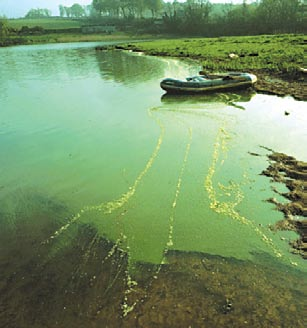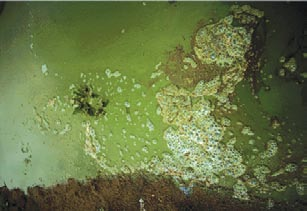ALGAE FACT SHEET
What Is Algae?
When high levels of nutrients drain into water reservoirs algae will usually form in large quantities generating “blooms”. For water use purposes the greatest concern arises from the growth of blue-green algae in the water. Blue-green algae are in fact not algae at all, but are bacteria and their proper name is cyanobacteria. Cyanobacteria produce both liver and brain toxins that can be as potent as cobra snake venom. The cyanobacteria Microcystis, Anabaena, and Aphanizomenon are common on water reservoirs and lakes across the prairie region.
This picture shows a highly toxic strain of the cyanobacterium Microcystis.
An agricultural stream in the foreground carrying clear, but nutrient-laden, water into a lake. This resulted in the proliferation of the cyanobacterium Microcystis.
Close-up of the Microcystis bloom.
As a rule, dugout water will be loaded with particles, including algae, while the water from the South Saskatchewan River will rarely have a high level of particles in it. Particles of concern are very small and are usually seen as a “haze”; a microscope is needed to see them clearly. In addition most dugout waters are typically brown in colour (caused by organic compounds) while water from the South Saskatchewan River is clear. Even after treatment, water from dugouts usually retain their colour as shown in the picture below.
Water distributed in a small community close to Saskatoon and in City of Saskatoon
Why does it matter if the water is brown and loaded with organic material? Dugouts typically contain up to 10 times more dissolved organics than the South Saskatchewan River, from which cities like Calgary and Saskatoon get their water. Untreated South Saskatchewan River water has almost no colour. The dissolved organics present in rural water supplies often smell and taste bad and they make it more difficult to disinfect the water. When one adds chlorine it reacts with the organics rather than killing the microbes. When the chlorine reacts with the dissolved organics, compounds that can cause cancer are formed. If properly disinfected, rural Saskatchewan water supplies will generally exceed guidelines for such compounds. In addition to organics, rural water supplies often contain agricultural chemicals such as pesticides. Water entering farm houses (and small rural communities) may not only look unappealing, but can also have unpleasant smells associated with it. It is unlikely that water that looks and smells poor is safe, even if toxic compounds and microorganisms don’t smell or taste.
This is a picture of a farmer running water from the kitchen tap.
The origin of this farmer’s problem was excessive growth of algae in the dugout supplying the water. This water made the whole house smell like rotten eggs.
Did you find this information useful? Please help us to write more informational pieces about drinking water quality issues and solutions. Please chip in $5 or donate $20 or more and receive an Official Donation Receipt for Income Tax Purposes.





